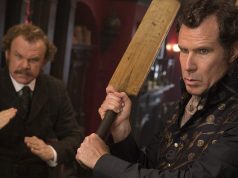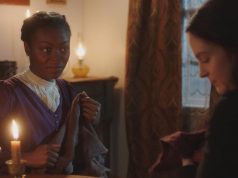The fear many of us had when it was announced Jim Carrey would play Ebenezer Scrooge and other parts in Robert Zemeckis’ adaptation of “A Christmas Carol” was that Carrey’s clowning would turn the story into a goofy farce. This fear turns out to have been unfounded. If anything, the opposite is true: The film has no personality at all, not Carrey’s or anyone else’s.
Charles Dickens’ holiday classic has already been adapted for movies and TV dozens of times, but Zemeckis noticed something peculiar: Somehow, none of the previous incarnations had managed to be in 3-D! He sought to rectify this oversight with that newfangled motion-capture technology he’s been so excited about the last several years, where actors’ movements are translated into animation. “The Polar Express” and “Beowulf” demonstrated that for as neat-o as the technology is for action scenes, characters’ faces — especially their eyes — look dead and soulless. Some improvement has been made in that respect, but most of the people in “A Christmas Carol” still look like creepy robots.
(The one exception: Scrooge himself. Since he’s in nearly every frame of the movie, the animators seem to have focused on getting his details right while letting everyone else’s slip. But even Scrooge’s eyes don’t look as natural and lifelike as Zemeckis keeps insisting they should.)
You are familiar with the story: cranky miser besmirches Christmas; is harassed by a series of terrifying ghosts; changes his ways (and, presumably, his now-soiled nightshirt). Zemeckis has not changed any of this except to add a few action sequences to justify the 3-D animation. For example, Scrooge shrinks to the size of a mouse during the Ghost of Christmas Future segment, for reasons not explained. “A Christmas Carol” is almost like a religious pageant now. You already know the story, even a lot of the dialogue; the fun, if there is to be any fun, is to see what particular flair the current performers have given it.
And what flair do we get here? Not much, sadly. Almost all of the dialogue is straight from Dickens, with those delightful Victorian cadences and vocabulary that will probably baffle young children. Carrey is surprisingly reserved and serious in his portrayal of Scrooge and the three Christmas ghosts. (You’d barely even know it was Jim Carrey were it not for the fact that the characters all kind of resemble him.) The whizzing 3-D stuff aside, this is a very faithful version of “A Christmas Carol,” at least outwardly. It just doesn’t FEEL like “A Christmas Carol.” The heart is missing. The supposedly joyful finale feels inert. The flashbacks meant to show how Scrooge became bitter show nothing of the kind. Very little of the film elicits any emotion other than wonderment at how cool the 3-D looks.
Curiously, there are important details missing. When Scrooge has his change of heart and tells the boy in the street to go buy the giant turkey hanging in the butcher’s window, the movie doesn’t tell us what he’s going to do with it. We know, because we know the story, that he’ll send it to the Cratchits. But that fact is omitted from the film — kind of a crucial point, don’t you think? And Scrooge’s nephew, Fred (voiced by Colin Firth), is never named. I’m not sure we ever hear the name of his childhood sweetheart, either (voiced by Robin Wright Penn). Scrooge is the central character, of course, but he’s not supposed to be the ONLY character. Part of what makes his reformation meaningful is the way it impacts his relationships with others, and the way it reflects on his past mistakes. To ignore everyone except Scrooge is to do the story a disservice. (It’s a waste of some talented actors, too, who include Bob Hoskins, Gary Oldman, and Cary Elwes.)
It goes back to what I said about “A Christmas Carol” being a pageant. We already know all the details; actually watching the film is just a formality. The external trappings here are marvelous to behold, purely from a technical standpoint (except for those dead-eyed robots, but apparently that can’t be fixed). A lot of work has obviously gone into producing the film. The fact that the result has no depth is almost beside the point, since the emphasis was clearly on technology, not storytelling. Most important: Charles Dickens’ lifelong wish to have his story retold as a three-dimensional cartoon has finally been realized. At last his soul may be at peace.
C (1 hr., 36 min.; )





